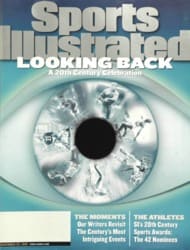
The Longest Long Shot SEPTEMBER 18-20 1913 FRANCIS OUIMET WINS THE U.S. OPEN
O.K., let's say, just by a fluke, you live next to a stadium.
Let's say, just by double fluke, they decide to hold the Super
Bowl there. Let's say they just happen to ask if you'd like to
play in that Super Bowl. Then let's say you don't just get in
the game, but you quarterback your team to the greatest upset in
American sports.
That's the latter-day equivalent of what happened to a skinny
caddie named Francis Ouimet at the 1913 U.S. Open. Ouimet, 20,
was kind of a dweeb. He was flagpole thin with big ears and a
pencil neck that made him look like Ichabod Crane. He was a
clerk at a sporting-goods store who still lived with his parents
in a small house at 246 Clyde Street, not more than a crushed
driver from the 17th green at the Country Club in Brookline,
Mass. Francis knew that course as well as he knew his bedtime
prayers. As a kid he had dashed through it on the way to the
Putterham School. He'd caddied at the Country Club since he was
11. He'd wandered its course for hours, hunting balls and
sneaking shots. When they let him, he played it legit.
Ouimet was the state amateur champion, but nobody figured he
would ever wind up winning anything much bigger than that. In
fact, when he was offered a last-minute spot in the Open, he was
reluctant to ask his boss at the sporting-goods store for the
time off. He wasn't asking for much, though. He figured he
needed only a day, just enough to miss the cut. For Francis,
just teeing it up in the Open would be the thrill of his life.
That's because he'd get to meet the two greatest golfers in the
world, two of his heroes--England's Harry Vardon and Ted Ray.
Vardon had already won five British Open titles. Ray was the
1912 British Open champion and the longest hitter in the game.
Ouimet playing in the same tournament as these two would be like
a milk boy in Leeds getting a chance to play with Tiger Woods
and David Duval.
Naturally he went out and played like a hack. With his
10-year-old caddie, a local kid named Eddie Lowery, at his side,
Ouimet hit his first tee shot about 40 yards. He doubled the
first hole. He doubled the second hole.
But then something strange happened. Ouimet started playing as
if he owned the joint. By the end of Thursday's 36 holes, he had
scrambled back to within four shots of the lead. By the end of
Friday morning's round he was tied for the lead, and the locals
were turning out in droves to watch the kid work his magic.
Ouimet started slowly in Friday's final 18, shooting a 43 on the
front, but with Vardon and Ray already in the clubhouse, the kid
played the last six holes in two under to tie. The decisive
moment came at the 17th--his very own 17th--where Ouimet looked
at a nasty, sliding, downhill 20-footer for birdie. By now
hundreds of neighbors and buddies had crowded around the green.
He creamed the putt, too hard but dead on line. The ball
practically knocked the hole backward a foot, but it popped up,
then into the cup for a 3. Spectators "yelled, pummeled each
other joyously, swatted their friends with umbrellas," Herbert
Warren Wind wrote. (Sound like any celebration you've heard of
on that green recently?)
Ouimet made a crucial par on 18, prompting friends and strangers
to hoist him up on their shoulders and parade him around like
he'd just shot the kaiser. Who would've believed it--a two-man,
one-boy 18-hole playoff set for the next day, with the whole
world sure Franny the Fluke would get flushed four holes into
it. Was Ouimet nervous? Please. He took a bath at the club,
walked home, went to bed at 9:30, slept until 8 the next
morning, walked back over to the course and found 10,000 people
waiting for him, many of whom had never seen a golf match in
their entire lives. Then he went out and changed the face of the
game forever.
Course, it didn't start that way. Ouimet looked a little shaky
until he hit the 5th hole, where he got worse. He cold-fanned
his approach so far right that it wound up out of bounds. Uh-oh,
back in the box, Pinocchio.
But do you know what Francis did then? He dropped one, took a
deep breath and stiffed his next shot a few feet from the stick
for the most wonderful bogey of his life. Ouimet was bulletproof
after that. He opened up a one-shot lead on 10, a two-shot lead
on 12, and then sealed it--guess where?--on 17 with an 15-foot
birdie. Always did love that green. He shot a 72 to Vardon's 77
and Ray's 78.
Nobody knew it, but Ouimet would become the Tiger Woods of his
day, the kid who proved you didn't have to be rich, British or,
for that matter, professional to be a golf champion. Ouimet's
win was not just the first by an amateur in the Open, it ended
Britain's domination of the golf world and started the American
ascension.
At the time, of course, nobody could see that. All people saw
was Ouimet posing for a picture with a lucky horseshoe, his
lucky caddie and the kind of lucky grin guys get only when they
skip work to play golf.
COLOR ILLUSTRATION: ILLUSTRATION BY JAMES MCMULLAN The obscure Ouimet had no illusions of making the cut; he ended up making history instead.
He cold-fanned his approach so far right it wound up out of
bounds. Uh-oh, back in the box, Pinocchio.

